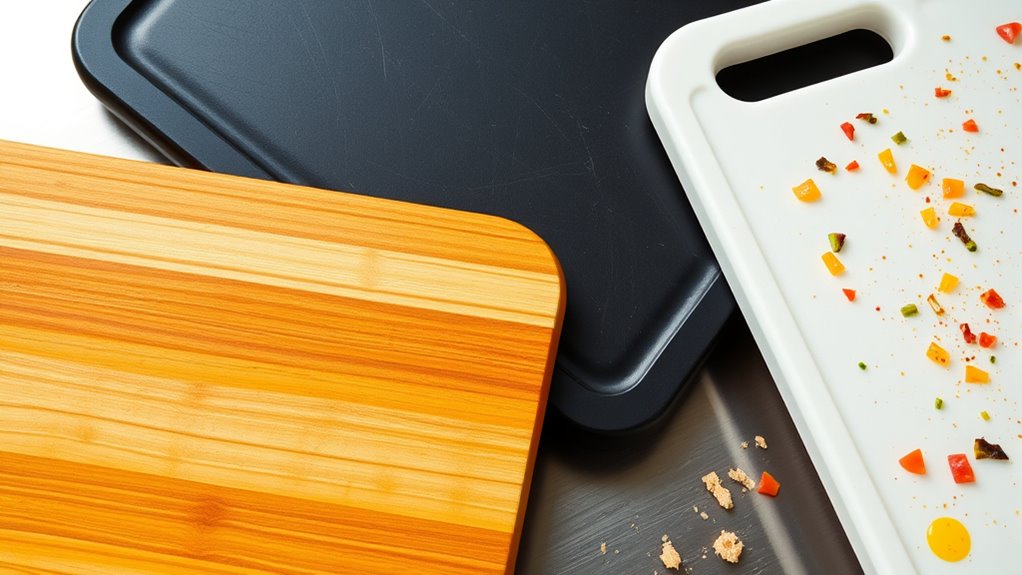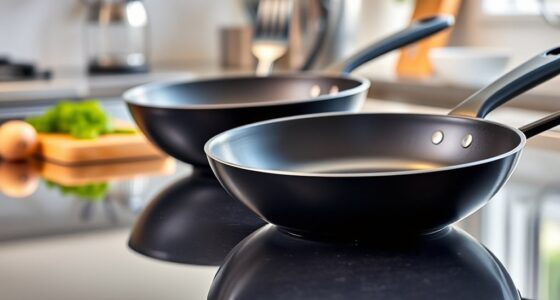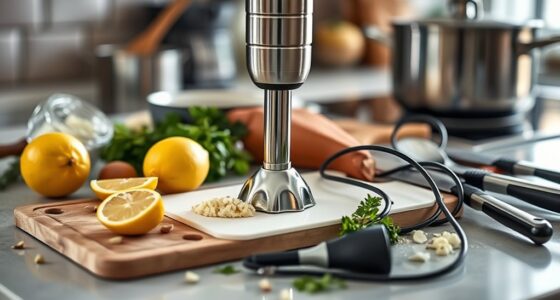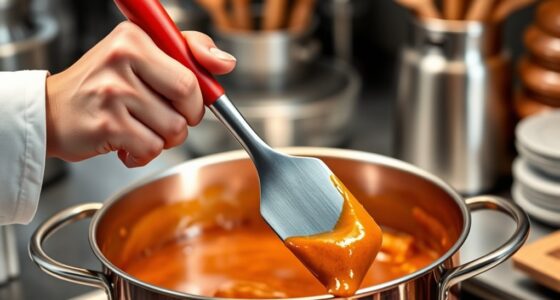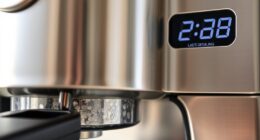When choosing between wood and plastic cutting boards, consider how each impacts hygiene and cross-contamination. Wood boards are durable and gentle on knives but can absorb juices and harbor bacteria if not properly cared for. Plastic boards are non-porous and easier to clean thoroughly, making them suitable for raw meats, but they develop deep cuts that can trap bacteria over time. Proper cleaning, maintaining, and replacing boards helps prevent cross-contamination — learn more to keep your kitchen safe.
Key Takeaways
- Wood cutting boards are durable and gentle on knives but can absorb juices, requiring regular cleaning and oiling to prevent bacteria buildup.
- Plastic cutting boards are non-porous, dishwasher safe, and ideal for raw meats, but develop deep cuts over time that harbor bacteria.
- Using separate cutting boards for raw meats and ready-to-eat foods minimizes cross-contamination risks.
- Proper cleaning—including hot, soapy water or dishwasher use—and replacing worn boards are essential for food safety.
- Understanding material differences helps prevent cross-contamination and maintains hygienic food preparation practices.
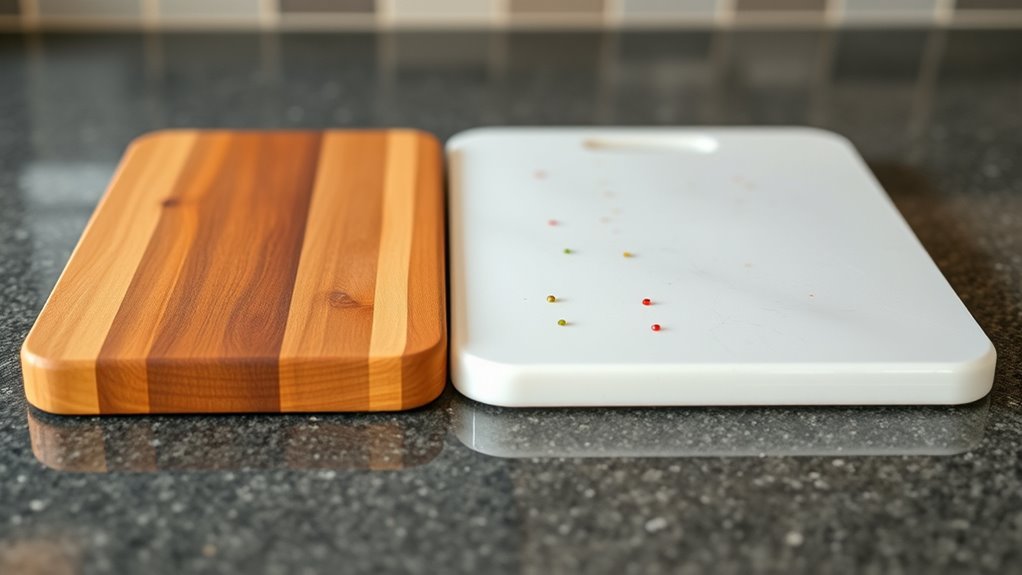
A cutting board is an indispensable tool in any kitchen, providing a safe and stable surface for preparing food. Whether you’re chopping vegetables, slicing meat, or dicing herbs, the right cutting board can make your tasks easier and safer. Choosing between wood and plastic depends on your cooking habits, preferences, and concerns about cross-contamination. Both materials have advantages and drawbacks, so understanding how they interact with different foods is key to maintaining a hygienic kitchen.
Wood cutting boards are praised for their durability and aesthetic appeal. They’re gentle on knives, helping to keep their edges sharp for longer. Plus, many people believe that wood has natural antimicrobial properties, which can help inhibit bacterial growth. However, wood boards are porous, meaning they can absorb juices from raw meats and other foods. If not cleaned and maintained properly, this porosity can harbor bacteria, increasing the risk of cross-contamination. To mitigate this, you should regularly scrub wood boards with hot, soapy water and consider oiling them to seal the surface. Avoid soaking them in water or putting them in the dishwasher, as excess moisture can cause warping or cracking. With proper care, wood boards can last for years and remain a beautiful, functional part of your kitchen.
Plastic cutting boards, on the other hand, are non-porous and easier to clean thoroughly. You can safely run them through the dishwasher, which helps eliminate bacteria more effectively than hand washing. This makes plastic boards a popular choice for handling raw meats, poultry, and seafood—foods that pose a higher risk of cross-contamination. However, plastic boards can develop deep cuts and grooves over time, which can trap bacteria even after washing. That’s why it’s important to replace them when they become heavily scored or warped. To keep plastic boards sanitary, you should inspect them regularly and replace them as needed. Using separate boards for raw meats and ready-to-eat foods is also highly recommended to prevent cross-contamination.
Additionally, the choice of dog names may reflect the personality or appearance of your pet, similar to how selecting the right cutting board depends on food safety and hygiene practices. Understanding the risks of cross-contamination is vital regardless of the material you choose. Cross-contamination occurs when bacteria from raw foods transfer to cooked or ready-to-eat items. Using a single cutting board for raw meat and vegetables without proper cleaning can spread bacteria and cause foodborne illnesses. To minimize this risk, you should designate specific boards for different types of foods, thoroughly clean them after each use, and replace them when they show signs of excessive wear. By being mindful of these practices, you can ensure your kitchen remains safe and your food stays fresh and healthy.
Frequently Asked Questions
How Often Should I Replace My Cutting Board?
You should replace your cutting board whenever it becomes deep in cuts, warped, or excessively stained, as these can harbor bacteria. For plastic boards, replace them every 1-3 years, especially if they develop deep grooves. Wooden boards can last longer if properly maintained, but replace them if they crack or splinter. Regularly inspect your board to guarantee it stays safe and hygienic for food prep.
Can I Sanitize Cutting Boards in the Dishwasher?
You can absolutely sanitize your cutting boards in the dishwasher, and it’s a smart move to keep them safe. Many worry about warping or damage, but most plastic boards are dishwasher safe and come out thoroughly cleaned. Just make sure to check your board’s label. Running it through a hot cycle with a good detergent destroys bacteria, giving you peace of mind when preparing food.
Are There Eco-Friendly Material Options for Cutting Boards?
Yes, you can choose eco-friendly cutting boards. Bamboo is a popular option because it’s renewable, durable, and naturally antimicrobial. Cork is another sustainable choice that’s lightweight and gentle on knives. Recycled or reclaimed wood boards also decrease environmental impact. When selecting, look for certifications like FSC to guarantee sustainable sourcing. By opting for these materials, you help protect the environment while maintaining a practical, safe kitchen tool.
What Are Signs of Bacterial Buildup on Cutting Boards?
Think of bacterial buildup on your cutting board as tiny invaders hiding in plain sight. You’ll notice a dull, fuzzy, or slimy film, especially in cracks or grooves. Discoloration or an unpleasant odor are also warning signs. If your board feels sticky or looks stained despite washing, it’s time to replace or thoroughly sanitize it. Regular cleaning and replacing old boards keep these invisible enemies at bay and your food safe.
How Do I Prevent Cross-Contamination Between Foods?
To prevent cross-contamination, you should always use separate cutting boards for different food types, like raw meat and vegetables. Wash your boards thoroughly with hot, soapy water after each use, and sanitize them regularly. Avoid placing cooked food on the same surface where raw ingredients were prepared. Keep your kitchen clean and organized, and replace worn or heavily stained boards to minimize bacteria spread.
Conclusion
Now that you know the difference between wood and plastic cutting boards, choose wisely to prevent cross-contamination. By properly cleaning, maintaining, and mindful material selection, you protect your plates and palate. Remember, your cutting board’s care counts—consistency is key! Keep knives clean, surfaces sanitized, and habits healthy. With these simple steps, you’ll stay safe, savor flavor, and sidestep sickness. Secure your kitchen’s safety—smart, sanitary, and superbly simple!
